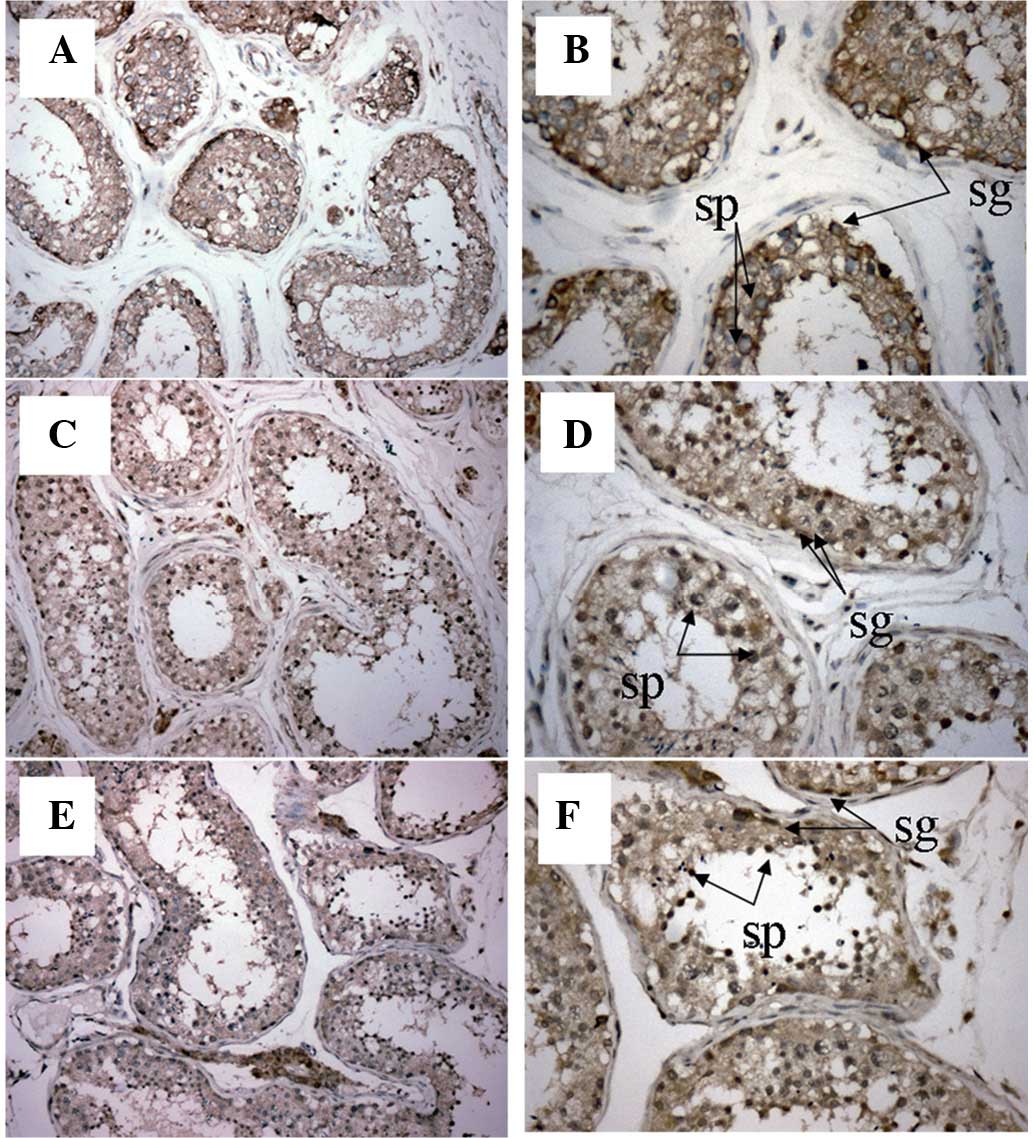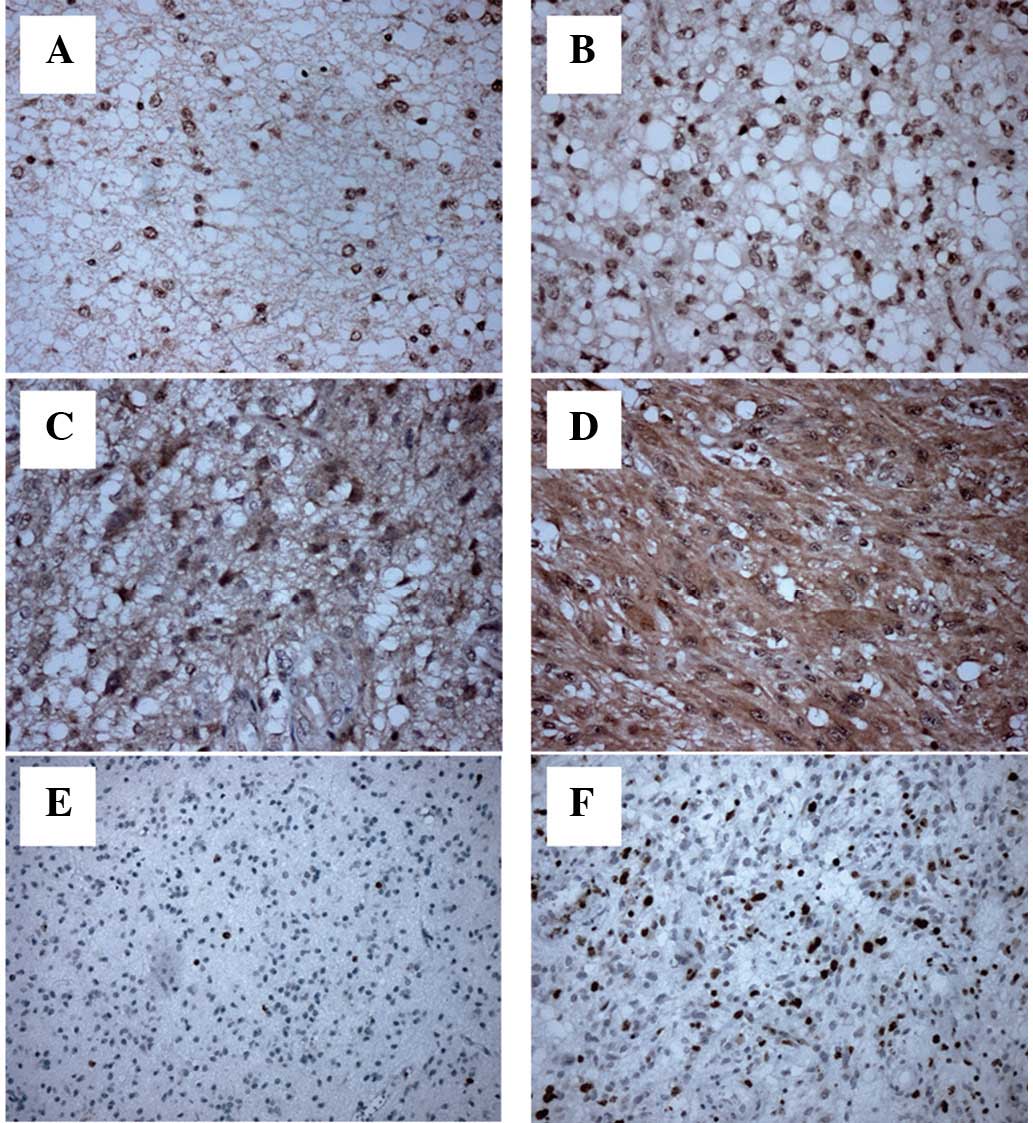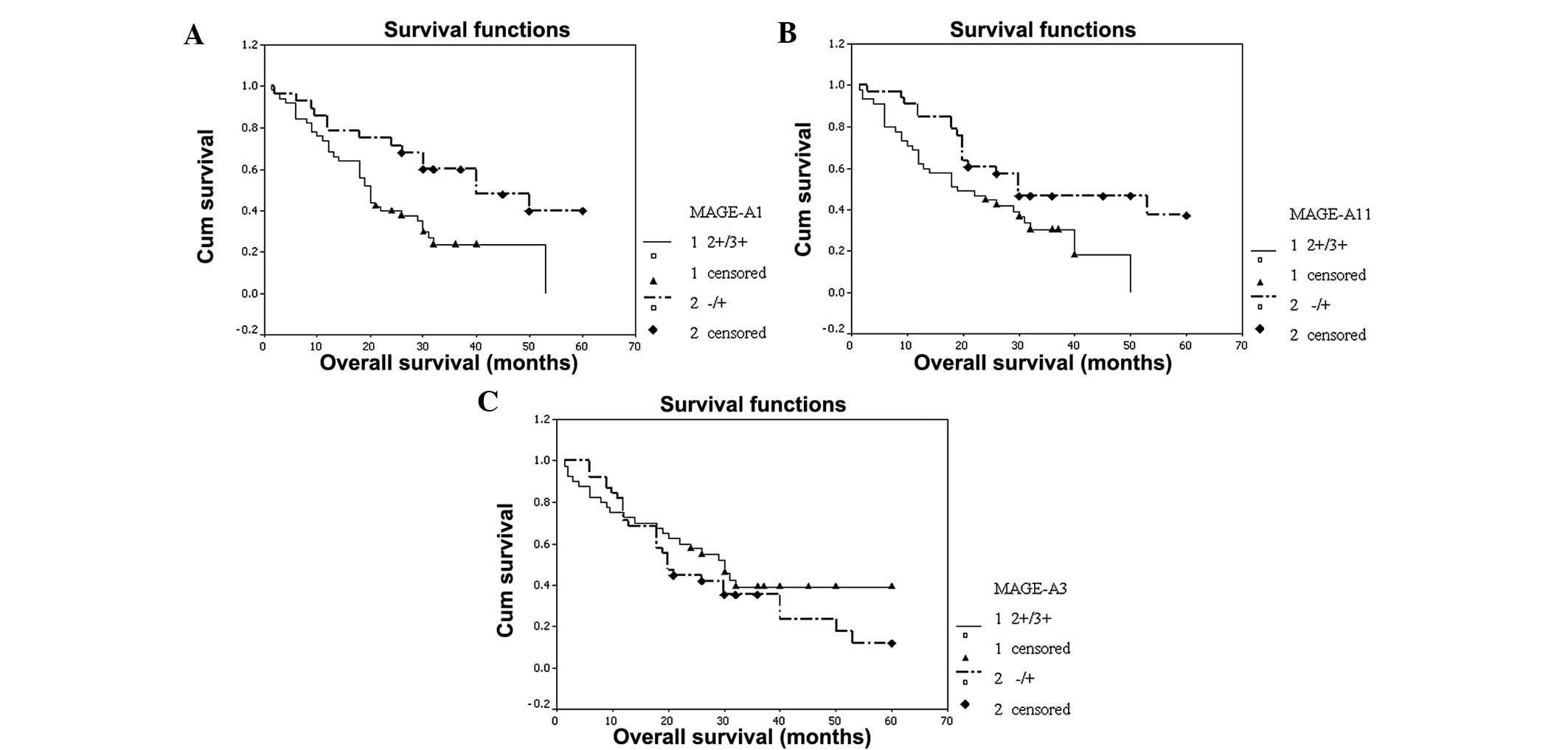|
1.
|
Parney IF, Hao C and Petruk KC: Glioma
immunology and immunotherapy. Neurosurgery. 46:778–792.
2000.PubMed/NCBI
|
|
2.
|
Surawicz TS, Davis F, Freels S, Laws ER Jr
and Menck HR: Brain tumor survival: results from the National
Cancer Data Base. J Neurooncol. 40:151–160. 1998. View Article : Google Scholar : PubMed/NCBI
|
|
3.
|
Scanlan MJ, Gure AO, Jungbluth AA, Old LJ
and Chen YT: Cancer/testis antigens: an expanding family of targets
for cancer immunotherapy. Immunol Rev. 188:22–32. 2002. View Article : Google Scholar : PubMed/NCBI
|
|
4.
|
Scanlan MJ, Simpson AJ and Old LJ: The
cancer/testis genes: review, standardization, and commentary.
Cancer Immun. 4:12004.PubMed/NCBI
|
|
5.
|
Zendman AJ, Ruiter DJ and Van Muijen GN:
Cancer/testis-associated genes: identification, expression profile,
and putative function. J Cell Physiol. 194:272–288. 2003.
View Article : Google Scholar : PubMed/NCBI
|
|
6.
|
Simpson AJ, Caballero OL, Jungbluth A,
Chen YT and Old LJ: Cancer/testis antigens, gametogenesis and
cancer. Nat Rev Cancer. 5:615–625. 2005. View Article : Google Scholar : PubMed/NCBI
|
|
7.
|
Chomez P, De Backer O, Bertrand M, De
Plaen E, Boon T and Lucas S: An overview of the MAGE gene family
with the identification of all human members of the family. Cancer
Res. 61:5544–5551. 2001.PubMed/NCBI
|
|
8.
|
Sang M, Wang L, Ding C, et al:
Melanoma-associated antigen genes - an update. Cancer Lett.
302:85–90. 2011. View Article : Google Scholar : PubMed/NCBI
|
|
9.
|
De Plaen E, Arden K, Traversari C, et al:
Structure, chromosomal localization, and expression of 12 genes of
the MAGE family. Immunogenetics. 40:360–369. 1994.PubMed/NCBI
|
|
10.
|
Rogner UC, Wilke K, Steck E, Korn B and
Poustka A: The melanoma antigen gene (MAGE) family is clustered in
the chromosomal band Xq28. Genomics. 29:725–731. 1995. View Article : Google Scholar : PubMed/NCBI
|
|
11.
|
van der Bruggen P, Traversari C, Chomez P,
et al: A gene encoding an antigen recognized by cytolytic T
lymphocytes on a human melanoma. Science. 254:1643–1647. 1991.
|
|
12.
|
Kuramoto T: Detection of MAGE-1 tumor
antigen in brain tumor. Kurume Med J. 44:43–51. 1997. View Article : Google Scholar : PubMed/NCBI
|
|
13.
|
Bodey B, Siegel SE and Kaiser HE: MAGE-1,
a cancer/testis-antigen, expression in childhood astrocytomas as an
indicator of tumor progression. In Vivo. 16:583–588.
2002.PubMed/NCBI
|
|
14.
|
Syed ON, Mandigo CE, Killory BD, Canoll P
and Bruce JN: Cancer-testis and melanocyte-differentiation antigen
expression in malignant glioma and meningioma. J Clin Neurosci.
19:1016–1021. 2012. View Article : Google Scholar : PubMed/NCBI
|
|
15.
|
Kleihues P, Louis DN, Scheithauer BW, et
al: The WHO classification of tumours of the nervous system.
JNeuropathol Exp Neurol. 61:215–225. 2002.
|
|
16.
|
Matos LL, Stabenow E, Tavares MR, Ferraz
AR, Capelozzi VL and Pinhal MA: Immunohistochemistry quantification
by a digital computer-assisted method compared to semiquantitative
analysis. Clinics (Sao Paulo). 61:417–424. 2006. View Article : Google Scholar
|
|
17.
|
Wild PJ, Kunz-Schughart LA, Stoehr R, et
al: High-throughput tissue microarray analysis of COX2 expression
in urinary bladder cancer. Int J Oncol. 27:385–391. 2005.PubMed/NCBI
|
|
18.
|
Ries J, Mollaoglu N, Toyoshima T, et al: A
novel multiple-marker method for the early diagnosis of oral
squamous cell carcinoma. Dis Markers. 27:75–84. 2009. View Article : Google Scholar : PubMed/NCBI
|
|
19.
|
Jang SJ, Soria JC, Wang L, et al:
Activation of melanoma antigen tumor antigens occurs early in lung
carcinogenesis. Cancer Res. 61:7959–7963. 2001.PubMed/NCBI
|
|
20.
|
Bergeron A, Picard V, LaRue H, et al: High
frequency of MAGE-A4 and MAGE-A9 expression in high-risk bladder
cancer. Int J Cancer. 125:1365–1371. 2009. View Article : Google Scholar : PubMed/NCBI
|
|
21.
|
Matković B, Juretić A, Spagnoli GC, et al:
Expression of MAGE-A and NY-ESO-1 cancer/testis antigens in
medullary breast cancer: retrospective immunohistochemical study.
Croat Med J. 52:171–177. 2011.PubMed/NCBI
|
|
22.
|
Jacobs JF, Grauer OM, Brasseur F, et al:
Selective cancer-germline gene expression in pediatric brain
tumors. J Neurooncol. 88:273–280. 2008. View Article : Google Scholar : PubMed/NCBI
|
|
23.
|
Chi DD, Merchant RE, Rand R, et al:
Molecular detection of tumor-associated antigens shared by human
cutaneous melanomas and gliomas. Am J Pathol. 150:2143–2152.
1997.PubMed/NCBI
|
|
24.
|
Sahin U, Türeci O, Schmitt H, et al: Human
neoplasms elicit multiple specific immune responses in the
autologous host. Proc Natl Acad Sci USA. 92:11810–11813. 1995.
View Article : Google Scholar : PubMed/NCBI
|
|
25.
|
Saikali S, Avril T, Collet B, et al:
Expression of nine tumour antigens in a series of human
glioblastoma multiforme: interest of EGFRvIII, IL-13Ralpha2, gp100
and TRP-2 for immunotherapy. J Neurooncol. 81:139–148. 2007.
View Article : Google Scholar : PubMed/NCBI
|
|
26.
|
Lian Y, Sang M, Ding C, et al: Expressions
of MAGE-A10 and MAGE-A11 in breast cancers and their prognostic
significance: a retrospective clinical study. J Cancer Res Clin
Oncol. 138:519–527. 2012. View Article : Google Scholar : PubMed/NCBI
|
|
27.
|
Bu N, Wu H, Sun B, et al: Exosome-loaded
dendritic cells elicit tumor-specific CD8+ cytotoxic T cells in
patients with glioma. J Neurooncol. 104:659–667. 2011.PubMed/NCBI
|
|
28.
|
Phuphanich S, Wheeler CJ, Rudnick JD, et
al: Phase I trial of a multi-epitope-pulsed dendritic cell vaccine
for patients with newly diagnosed glioblastoma. Cancer Immunol
Immunother. 62:125–135. 2012. View Article : Google Scholar : PubMed/NCBI
|
|
29.
|
Schvartzman JM, Sotillo R and Benezra R:
Mitotic chromosomal instability and cancer: mouse modelling of the
human disease. Nat Rev Cancer. 10:102–115. 2010. View Article : Google Scholar : PubMed/NCBI
|
|
30.
|
Weigel MT and Dowsett M: Current and
emerging biomarkers in breast cancer: prognosis and prediction.
Endocr Relat Cancer. 17:R245–R262. 2010. View Article : Google Scholar : PubMed/NCBI
|
|
31.
|
Rao CV, Yamada HY, Yao Y and Dai W:
Enhanced genomic instabilities caused by deregulated microtubule
dynamics and chromosome segregation: a perspective from genetic
studies in mice. Carcinogenesis. 30:1469–1474. 2009. View Article : Google Scholar : PubMed/NCBI
|
|
32.
|
Yoshida Y, Nakada M, Harada T, et al: The
expression level of sphingosine-1-phosphate receptor type 1 is
related to MIB-1 labeling index and predicts survival of
glioblastoma patients. J Neurooncol. 98:41–47. 2010. View Article : Google Scholar : PubMed/NCBI
|
|
33.
|
Yerushalmi R, Woods R, Ravdin PM, Hayes MM
and Gelmon KA: Ki67 in breast cancer: prognostic and predictive
potential. Lancet Oncol. 11:174–183. 2010. View Article : Google Scholar : PubMed/NCBI
|
|
34.
|
Torp SH: Diagnostic and prognostic role of
Ki67 immunostaining in human astrocytomas using four different
antibodies. Clin Neuropathol. 21:252–257. 2002.PubMed/NCBI
|
|
35.
|
Johannessen AL and Torp SH: The clinical
value of Ki-67/MIB-1 labeling index in human astrocytomas. Pathol
Oncol Res. 12:143–147. 2006. View Article : Google Scholar : PubMed/NCBI
|
|
36.
|
Paulus W: GFAP, Ki67 and IDH1: perhaps the
golden triad of glioma immunohistochemistry. Acta Neuropathol.
118:603–604. 2009. View Article : Google Scholar : PubMed/NCBI
|
|
37.
|
Xia LP, Xu M, Chen Y and Shao WW:
Expression of MAGE-A11 in breast cancer tissues and its effects on
the proliferation of breast cancer cells. Mol Med Rep. 7:254–258.
2012.PubMed/NCBI
|
|
38.
|
Grau E, Oltra S, Martínez F, et al:
MAGE-A1 expression is associated with good prognosis in
neuroblastoma tumors. J Cancer Res Clin Oncol. 135:523–531. 2009.
View Article : Google Scholar : PubMed/NCBI
|
|
39.
|
Dellaretti M, Reyns N, Touzet G, et al:
Diffuse brainstem glioma: prognostic factors. J Neurosurg.
117:810–814. 2012. View Article : Google Scholar : PubMed/NCBI
|


















